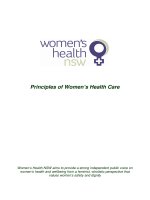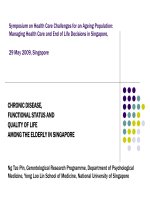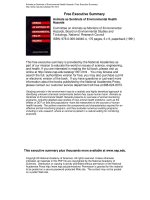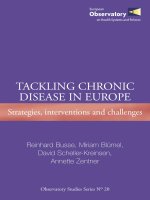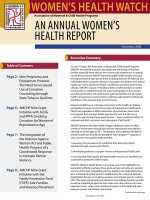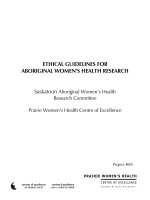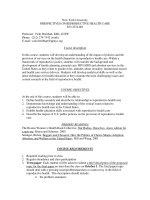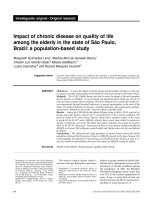CHRONIC DISEASE HEALTH REPORT docx
Bạn đang xem bản rút gọn của tài liệu. Xem và tải ngay bản đầy đủ của tài liệu tại đây (719.94 KB, 75 trang )
CHRONIC DISEASE
HEALTH REPORT
Preface
This book is simple in its design. Glyconutrition is, I believe,
one of the health technologies which is already impacting the
health world. It has earned four Nobel Prizes in the last eight
offered in the field of medicine, which is a powerful testimony in
and of itself.
However, glyconutrition is already referred to as one of the
top ten technologies which will change our world. That is the
position of the prestigious M.I.T. referencing this field of
“glycomics” (a commonly used scientific name), which is the
field of glyconutrition (popularized name among scientists and
laity alike).
Most people have never heard of glyconutrition. But, every
day more and more people learn of its amazing impact upon the
human body. The impact on chronic diseases is immense.
Diseases ranging from the very dangerous diabetes, cancer,
Aids and heart disease to rather low level annoyances such as
rhinitis, hives, and gum disease have all been impacted by
glyconutrition.
But, therein lies the problem. The claims made for
glyconutrition seem too unbelievable. It’s become almost a sort of
“magic pill” approach in the minds of many. But, of course, it is
NOT a magic pill. Indeed, there is nothing magic about it.
The reason it affects so many health conditions is due to the
fact that it plays several key roles in health and nutrition.
Glyconutrition is the immune system modulator. In other words,
it is responsible for adjusting and regulating the immune system
“resources” of the body for carrying on their proper functions
against varied and multiple threats to the body…simultaneously.
This is an enormous task, surely, yet one which is performed
constantly by our bodies …unless we are lacking in the necessary
constituents, particularly the glyconutrional constituents.
Without the glyconutritional factors, you cannot stay “well”
no matter what other supplements you are taking. That may
sound like a bold statement, but it is no bolder than my saying
“You must have vitamin C for scurvy. Without vitamin C, you
cannot stay “well” from scurvy no matter what other supplements
you are taking.” Why? Because the body needs the specific
factors if the body is to stay well.
That is the problem. Given its immense impact and so many
claims concerning its use, the facts are simply too good to be
true…and therefore, hard to believe.
For the sake of clarity on the subject, I’ve chosen to present
this book containing articles I’ve authored on the subject.
However, I have chosen to begin the book with an article
written by my “copywriting mentor” who is a professional
researcher, writer and internet marketing specialist. His article
begins this book and is designed to introduce the subject, making
it easier to understand the issues at a foundational level.
I hope this helps you or someone you care about. If only I had
been given access to this information when I was in medical
practice, I believe many of my patients would have benefited
from glyconutrition enormously.
Dr. Robert Gamble
Cardio-Vascular and Thoracic Surgeon (retired)
About the Authors
Dr. Robert Gamble is retired from a very successful
medical/surgical career spanning three decades. He is now active
in researching medical issues such as glyconutrition … and offers
his insights for public benefit.
For information about Glyconutrition:
On the Web go to: www.glycoshare.com
or write (e-mail):
Wayne C. Sedlak is the President of A&D Net Enterprises. An
educator, internet marketer, radio talk show host and professional
researcher in a career spanning the past 25 years.
Questions? Email:
or Call Toll Free: 1866.735.5871
Glyconutrition… and Jesse James
Wayne C. Sedlak
Internet Marketing Specialist
Health Researcher
Glyconutrition …and the Medical Authorities
You would be surprised if you knew how many medical and
health authorities are involved in the research of glyconutrition.
M.I.T. calls the entire glycomics field one of the top ten
technologies which will shape our future.
Four Nobel Prizes out of the last eight have been awarded in
Medicine for discoveries in glycobiology (the field of
glyconutrition.)
So what does this have to do with Jesse James? Well, for one
thing, we are pretty sure that Jesse James did not die because of
poor nutrition. We are equally sure he had next to nothing to do
with the discovery of glyconutrition. In fact, to the best of my
knowledge, this article is the only source tying Jesse James with
glyconutrition.
Of course, that’s no great accomplishment,
seeing Jesse James has been linked with all sorts
of events in our history. Mostly unbelievable
too. Some say he was the real assassin of
Abraham Lincoln. Some say he was not the one
killed by the cowardly Ford gangster with a shot
to the back of the head. Some say he traveled
overseas and lived out his days in a foreign
country. Some say he moved to Canada to escape
the law here…
Still others say he lived a full life and died sometime in the
early 20
th
Century. It seems like no matter who you talk to, when
the name “Jesse James” comes up, you get some version of an
American “Robin Hood”, a train robber, a ruthless murderer, a
kind father, a good family man, a former Confederate “avenging
the proud ole South,” a religious man, and a philanthropist. He
even tried out for Baptist.
Hard to know what’s true and what isn’t. Everybody sounds
convincing…well, to some extent.
I suppose we could add our two cents worth to the fine
tradition. I suppose we could say he discovered glyconutrition
way ahead of his time…and that’s how he survived all of those
bullets. It was glyconutrition that gave him all that energy for
those bank and train robberies, and glyconutrition was his special
“aging antidote.” So he lived to a ripe ole age…when the rest of
America was not averaging anywhere near 70 years old…which
he purportedly surpassed. Can you explain that?
Hard to believe all of the claims, isn’t it? But, that’s how
legends are born.
Frankly, that’s the problem when dealing with glyconutrition
also. So many claims. But, it sounds so convincing and “all-
encompassing” that people become suspicious. It just seems to
be too good to be true.
After all, glyconutrition is a new health discovery … and the
subject of four Nobel Prizes. Let that sink in. That isn’t normal,
even for Nobel Prizes.
As stated, the field of glyconutrition (glycomics) has been
hailed in 2003 by M.I.T.’s Technology Review as one of the 10
emerging innovative fields which will change our world.
1. Glyconutrition is now known as a breakthrough in stem
cell production and research.
2. Glyconutrition is the key to cellular communication … and
thus to our immune system.
3. Glyconutrition answers the “why” question of certain
“healing” substances such as aloe vera, breast milk,
Echinacea, garlic, coconut milk, certain anti-bacterial
mushrooms - since each of these contains glyconutrition.
4. Glyconutrition is responsible for helping people with
certain cancers, heart disease, arthritis, diabetes, flu,
sinusitis, HIV, shingles, asthma, strep, TB, Candida,
eczema, hepatitis B and C, Herpes Simplex 1 and 2, MS,
Psoriasis, Lupus, Crohn’s Disease , Celiac, Ulcers,
Ulcerative Colitis, ADD, ADHD, Infertility, Alzheimer’s,
Scleroderma…
5. And yes…even “aging.”
Now, do you see the problem? It seems to do just about
everything. Like Jesses James.
But, there’s a reason for that.
If you were Jesse James, and someone asked you “What do
you do for a living?” you wouldn’t say, “Well, I am a train,
stagecoach and bank robber.” You might say something like,
“I’m into banks.” Or… “I’ve made a career in finance.” You
might even mumble something about how much in demand you
are in the transportation industry.
It’s important to get it right about glyconutrition. We live in a
society that’s used to dealing with each disease condition
separately. Everything is assumed to have an antidote of its
very own.
If you were to ask your doctor what cures strep, he might say
penicillin. If you were to ask, “What cures cancer?” the doctor
might say radiation and chemotherapy.
Actually, those are mistaken answers. You see, none of those
“antidotes” are the primary remedy for any disease. The primary
antidote is your immune system.
Which is the reason glyconutrition is a tough sell. Telling
people what it does with our immune system leaves them
wondering if you are giving them an “I’m into banks” kind of an
answer. Telling them things such as…
1. Glyconutrition strengthens the immune system to produce
white blood cells — macrophages and lymphocytes —
immune killer cells which attack malignancies.
2. Glyconutrition facilitates the production of B cells which
produce substances that target cancer cells…
3. Glyconutrition activates T-cells to recognize and destroy
invasive and abnormal cells.
4. Glyconutrition helps regulate the process of apoptosis —
the natural "dying off" process in cellular systems.
True? Yes.
Exciting? Hardly.
Sounds more like a lecture in chemistry class…
Statements like these impress people about as strongly as
telling them you’re the greatest hockey player in Uruguay.
People want to hear something direct (and even sensational)
such as, “It kills cancers because it has this special element that
“zaps tumors.” People have a hard time envisioning a substance
that bolsters the immune system. Granted, that is a huge truth
because it affects all diseases and health conditions known to
mankind. But, most people yawn right through it.
People like it simple and direct. But, “direct” is not always
best, especially if it’s not complete.
Here’s “direct”. Glyconutrition does not kill anything. It does
not cure anything. It does not attack anything.
What it does is provide eight substances (albeit sugars – there
are over 200 sugars in nature) for the body. Those sugars provide
each cell with capabilities which bolster the immune system and
intercellular communication. You can’t live without those eight
sugars.
In short, a deficiency of these extraordinary sugars is linked to
everything from diabetes to arthritis…from flu to strep…from
allergies to psoriasis. Glyconutrition is so basic to life that every
cell in the body needs it. Glyconutrition is the
chemistry which provides the atomic strength for
the immune system.
Glyconutrition can leap tall buildings in a
single…
Ahhhh…maybe I’ll just tell ‘em that’s
why Jesse James lived so long.
References:
Jon Cohen, “Glycomics,” in Technology Review, February 2003.
www.technologyreview.com
Nobel Prizes: Nobel Prize Internet Archive (almaz.com/nobel/)
in field of Physiology and Medicine. 1996, 1999, 2001,
2002.
Stephen Boyd, “History of Nutrition and Health,” in
GlycoScience & Nutrition, January 8, 2000.
www.glycoscience.com
Bill H. McAnalley, and Eileen Vennum, “Introduction to
Glyconutritionals,” in GlycoScience & Nutrition, January
1, 2000. www.glycoscience.com
Emil I. Mondoa and Mindy Kiutei, Sugars that Heal, Ballantine
Publishing, New York, 2001.
This is what they call “Hope”?
Dr Robert Gamble
Cardiac and Thoracic Surgeon (retired)
We’ve all gotten used to the idea certain maladies
will be around for a while…like until the Second
Coming. Maladies such as cancer, heart
disease, diabetes, arthritis…and many more
are expected to be around, in epidemic
proportions, longer than we think we will be alive…and anyone who
tries to tell us otherwise is looked upon with real skepticism. In fact,
when anyone tries to tell us “there’s hope” for such maladies as say,
diabetes, we are more likely to believe the person is trying to sell us
something…and usually we are right.
But, what’s even worse is the fact that the “hope” we do receive
is usually something like the following:
Studies show people at high risk for type 2 diabetes can prevent
or delay the onset of the disease by losing 5 to 7 percent of their body
weight. You can do it by eating healthier and getting 30 minutes of
physical activity 5 days a week. In other words: you don’t have to
knock yourself out to prevent diabetes. The key is: small steps that
lead to big rewards. Learn more about your risk for developing type
2 diabetes and the small steps you can take to delay or prevent the
disease and live a long, healthy life.
Of course, this is good advice. No denying it. As a medical doctor,
I had to dispense advice like this for years, for diabetes and other
conditions. Funny, as good as it is, I haven’t seen anyone become
ecstatic, do cartwheels or celebrate because they had just received
such counsel. Why? Because what we really want from the medical
world, is a cure.!
And why not? It just doesn’t seem fair the only real answer to
conditions like diabetes or obesity is the “hope” that means we stop
eating almost everything we enjoy, sweat till we drop, “pop”
prescription pills ‘till we’re bloated, and think positive…forever.
A new future?
So, of course, I was skeptical too when I began to hear the claims
associated with glyconutrition. As a long time medical professional
and scientist, I know “claims” are easily made… And who ever heard
of “glyconutrition” anyway?
In 1999, the Nobel Prize for Medicine was awarded to Dr. Gunter
Blobel for his work in the science of Glycobiology (the biology of
glyconutrition). Out of the last eight Nobel Prizes awarded in
medicine, four Nobel Prizes have been awarded for discoveries made
in this ONE field. Believe it or not, this field (glyconutrition) affects
maladies such as diabetes, cancer and heart disease directly. Why?
Because, eight sugars have been isolated for their support of the
immune system and cell communication.
Additionally, human life cannot be supported without them.
This information got my attention. When a single Nobel Prize is
won in medicine, everyone is paying attention. When four of them
are won in the SAME field, as in this case involving glyconutrition,
the medical world is “on fire” with the news.
As that information made its way through the medical world, other
issues made the news too. For decades the American Medical
Association, the powerhouse of medical professionals, taught that
nutritional supplements were not necessary for good health. But, in
June 2002, the AMA admitted that nutritional supplementation was
vital to good health and helpful in treating diseases.
Also, the prestigious MIT published its findings. It wrote that
these “sugars” were one of ten technologies it believed would change
the world in the next decade. Nutritional supplementation was again
vital to the conventional medical world…and at the center of the
storm was glyconutrition.
But, what really jolted me professionally was this: Until these
discoveries, scientists had NO idea how the cells of your body could
tell the antibodies of your body you had an infection and that they
had to “get on over here” to deal with it. Until these discoveries,
scientists had NO idea how the cells of your body told the rest of
your body they needed nutrition, oxygen, waste elimination,
infections healed…and a thousand and one other necessary functions
of every cell. Goodness! We in the scientific world hadn’t known just
exactly HOW even aspirin made its way to that headache of yours.
We just knew it worked. So, we prescribed it.
Sugar? Say it ain’t so, doc!
But, my attention was riveted to the news that scientists like Dr.
Gunter Blobel had discovered what it was that let the cells
COMMUNICATE with the other systems of the body. And would
you believe it? What he found was amazing. Sugar…SUGAR!
(Glyco = Greek for “sugar”) No…not table sugar (else diabetics
wouldn’t be so excited over this new-found help for their diabetes).
There are over 200 sugars in nature but, eight of them are VITAL to
our good health. In fact, eight of them are the glyconutrition
“backbone” for helping the body prevent or heal
Auto-immune diseases such as:
Diabetes
Psoriasis
Overactive immune disorders such as:
allergies
asthma
Under active immune disorders such as:
cancer
TB
strep
Inflammatory disorders such as:
colitis
ulcers
Fibromyalgia
Other conditions such as:
Alzheimer’s (probably inflammatory)
infertility (multiple causes)
heart disease (probably inflammatory)
Suddenly, the medical world was on fire over glyconutrition. The
“anecdotal evidence” concerning glyconutrition is mounting rapidly
as people are finding conditions which have long grieved them…to
be a thing of the past. For so many, the expectation for the future is
not a “long, long, road” fraught with impossible dieting, grueling
workouts, thousands of dollars of prescriptions, and the need to
dream positively. People are getting relief – from diabetes, heart
disease, cancer, allergies, and many others - with glyconutrition…and
without prescriptions! (Glyconutrition products are NOT
prescription items…they’re food.)
Oh yes. I almost forgot. If you go to your doctor and he isn’t
aware of glyconutrition, don’t panic. Your poor doctor CANNOT
possibly keep up with all of the signs, symptoms, conditions, and
their myriads of treatments, chemical make up and complications
associated with thousands of maladies and the myriads of
prescription antidotes for those maladies. I couldn’t as a doctor, and
I had several DECADES of experience in the field. “Been there …
done that” as they say. Only Doctor’s coming
out of Medical school now are receiving this
vital information. And continuing education
will include the field of glyconutrition.
Incidentally, doctors don’t usually find out
first what works. They’re just too busy being
overwhelmed with the medical conditions they face, day to day. They
usually find out like everyone else…They read about it or attend
some seminar. Often, the marketplace produces antidotes – or
research finds the right treatment, as in this case – long before they
do.
But, I can tell you this. Glyconutrition is helping conditions as
diverse as diabetes and Alzheimer’s … and a lot of people have hope
that these conditions CAN be and are being…overcome…
Suddenly, the future isn’t what it used to be…
Antioxidants, Free Radicals
and Sports Nutrition
Dr. Robert Gamble
Cardio-Vascular and Thoracic Surgeon (retired)
Sports nutrition and antioxidants
As you know, I am a physician. It’s part of my profession to keep
abreast of what’s happening in medical /health research. Being retired
helps, because doctors simply do not generally have the “extra time”
to devote to the scientific literature.
But I do. And I love it. I am one of those individuals who really
enjoys …brace yourself…chemistry. When I’m done here, you
should be excited too, especially if you are interested in sports
nutrition and antioxidants, though not necessarily in that order.
Sports nutrition is a vast industry with emphasis on optimizing
PERFORMANCE. Off hand, I can think of quite a few categories
involving sports nutrition:
sports nutrition and supplements for athletes,
sports nutrition and athletic performance,
sports nutrition and body building,
sports nutrition and endurance training,
sports nutrition and special diets in a variety of sports,
sports nutrition and strength training,
sports nutrition for running, jogging, walking, skiing, swimming,
there’s even Rocky Mountain sports nutrition.
… the list is endless.
So far, no surprises, huh? Well, here’s one for you. Did you
know when you exercise intensively you INCREASE the free
radical burden in your body? If you’re a serious sports enthusiast,
you should know that.
But…the real news is what science is now finding out about
that free radical burden of yours. You should pay close attention
here.
Suddenly, chemistry gets real personal.
Every one of us has, what may be called, our antioxidant
protective capacity. That means our bodies normally utilize
antioxidants to protect us against the harmful impact of free radicals.
First of all, what are antioxidants? They are molecular substances
which offset free radical damage to the body. Antioxidants, “quench”
free radicals (for lack of a better metaphor) neutralizing their
damaging effects on the cells of the body.
1. Antioxidants are found in foods such as cranberries, green tea
and even chocolate.
2. Antioxidants are found in vitamins such vitamin C and E.
3. Antioxidants are found in carotenoids such as beta-carotene.
4. Antioxidants are found in many substances supplied by the
body such as glutathione.
5. Antioxidants are found in many herbs and enzymes.
The impact of antioxidants is boosted by glyconutrients to offset
free radicals in your body…and, as a result of your athletic exertions.
Antioxidant capacity must be provided in your sports nutrition
regimen or you could be “robbing Peter to pay Paul” with your
workouts. As you will see, without a glyconutrional presence in your
sports nutrition, the healthful gains made by your physical workouts
will be offset by your own free radical burden.
Free radicals, sports and sports nutrition
Free radicals are those chemical species which contain
one or more unpaired electrons, capable of independent
existence. They form in the body due to a variety of reasons as
offshoots of cellular activity or as products introduced to the body
from the outside.
As an analogy, think of running a car engine as the cellular
production and the car emissions a the free radical production. The
engine produces products which cannot stay inside the car without
further damage. They simply must be neutralized and expelled.
Free radicals form and cause damage by reacting with many
substances in your body. It is estimated that upwards of 200,000 free
radical attacks occur in our bodies daily.
When free radical damage is done, the body can remove the
compounds formed by its cellular repair system. However, if the
body cannot handle the free radicals (with antioxidants for example),
nor remove the compounds, then disease can be the result.
Contrary to popular opinion, free radicals do not circulate
throughout the body. The half-life of most free radicals varies in a
range of a few nanoseconds to about 7 seconds duration. That means
they will react within the “neighborhood” (a few Angstroms or
microns near where the increase in free radicals occurred) …organs,
connective tissue, circulatory or nerve tissue, bone or lymphatic
material are all candidates for free radical attack.
Wherever they form, they will damage the surrounding areas,
unless prevented by the body…So the body does NOT have the
luxury of just filtering away any circulatory fluids to find the free
radicals. The body’s defense systems must be…well…fairly
omnipresent to neutralize the effects of free radicals. The antioxidant
protective system must be healthy.
Since they are highly reactive substances, they react with all sorts
of cell elements readily. But, when they do react with your body
cells, they can damage the cells and even kill them. Often, the
damage from free radicals can CHANGE the cellular structure
enough to cause DISEASE such as cancer, diabetes, arthritis, heart
disease and a host of others.
The type of disease that occurs is dependent upon which of the
free radical defenses in the body weren’t functioning
properly and where the free radical attacks occur.
The body has pretty sophisticated antioxidant
defense systems. But, the body CAN get
overwhelmed in its antioxidant protections
against such free radicals …
Indeed, unless antioxidant enhanced sports nutrition (with
glyconutrients) are used to offset the increased free radical burden,
the BODY will suffer as a result of intensive sports training, stress,
and competition.
Glyconutrients VITAL to sports nutrition …
Studies comparing marathon runners who did and did not take
glyconutritional sports nutrition supplements were undertaken. The
results were reported by the Proceedings of the Fisher Institute For
Medical Research (August 2003, vol.3, no.1). The results
“demonstrated strikingly different patterns.” Antioxidant protection
appeared to be powerfully enhanced against free radicals with
glyconutritional supplementation. Thus, the body was protected for
several days after the marathon run.
However, when glyconutritional sports nutrition was NOT used,
the damaging effects of the free radical burden appeared to remain in
the body for about five days. Thus, the subject “consistently
excreted higher concentrations of free radical byproducts …” as
compared to that of the glyconutritional subject. It should be
emphasized that the subject studied WAS TAKING other
antioxidants, though not glyconutrition. Despite that fact, the above
cited results were obtained.
That’s another way of saying that when glyconutritional
supplements were not used, the free radical burden upon the body
was not lifted. Antioxidant protection does appear to be
(significantly) strengthened with glyconutritional sports nutrition.
Such antioxidant protection appears to be of benefit for athletes
overall, including training, stress, competition and dietary issues.
The glyconutrional revolution in sports nutrition and therapy is
just beginning. More studies are being done. More results are coming
in concerning free radicals and the capacity of the glyconutrients to
boost antioxidant affect against free radicals.
Sports nutrition is about to see a new revolution …
Better still. I believe that it is quite probable that, with
glyconutrition, sports PERFORMANCE is about to see a revolution
in all fields.
Glyconutrition: All Eyes on Newton
Dr. Robert Gamble
Cardiac and Thoracic Surgeon (retired)
Glyconutrition and the silence in Parliament:
Sir Isaac Newton is not generally associated with medicine
and biology, much less glyconutrition. Newton lived 1642
1727, a period now referred to as the Age of Newton. However, you
don’t get an entire age named after you unless you have done
something spectacular … like inventing the calculus … or
discovering the law of gravity and the laws of optics.
His impact was so enormous, even in his own lifetime, people of
all stations in life wanted to get just a glimpse of him…or hear
anything he had to say. Problem was, he was very sensitive and shy,
so words didn’t come easily, ergo, he didn’t say much.
Except in the lecture hall of the University, where very
occasionally he did lecture. (Granted, not on glyconutrition but we
haven’t gotten there yet).
There…he did open his mouth. Imagine, sitting
through a lecture of the world’s greatest scientist, who
didn’t know when to stop lecturing on subjects his
students couldn’t understand. That may be the real
origin of the expression, “In every fat book there is a
thin book trying to get out.”
In any event, because of his enormous popularity as the greatest
mathematician and scientist in history, he was elected to the
Parliament of England. I guess people just figured if they could get
him involved in politics, he might say something which they could go
home and quote.
So, he sat in Parliament year after year and never uttered a peep.
Not a single syllable. At least, not until one day, in the middle of an
intensely debated issue in Parliament, Sir Isaac suddenly stood up.
Immediately, Parliament was silent as all eyes were upon Sir Newton.
Mustering such abilities as he was capable of
producing for the drama of the moment, Sir Isaac
turned sheepishly and asked that the window be
closed because of the draft.
Not a particularly moving event. But, it became buzz nonetheless.
Glyconutrition: Accessing the nutrients is a key to health.
So what does all of this have to do with glyconutrition?
Actually, we don’t remember Isaac having anything to do with
glyconutrition. There’s a good reason for that. Medical science still
hadn’t discovered bacteria under the microscope, let alone the 8
sugars which comprise the key molecules in glyconutrition,
observable only under the electron microscope.
But, Sir Isaac and the people of “merry ole England” were
unconsciously accessing glyconutrition far more readily than we do
today … through their diet:
• Glyconutrition supplied the essential ingredients of protection
for newborns who were breast fed. The sugars involved with
glyconutrion are present in surprising quantities for the baby.
• Garlic, certain saps and quite a few of the herbs rich in
glyconutrition, were part of the diet in merry ‘ole England of
that day.
• England didn’t then resort to “green harvests”, processed
foods, chemical preservatives which destroy glyconutrition.
Indeed, our society depletes the soil, processes food for taste
and convenience and introduces toxins that overwhelm our
immune system. What little glyconutrition we do get, is
simply not enough to do the job.
• Instead, glyconutrition was not processed out of the corn,
oats, barley, wheat, leeks, carrots, radishes, pears, and red
wine of that society. Granted they had other problems (like
the two years of diminished sun which brought on starvation
and eventually the Black Death), but not for lack of
glyconutrition.
• Fruits are loaded with pectins (such as apple pectins) and are
instrumental in providing glyconutrition.
It is, for that reason, “merry ole England” did not see the huge
epidemics in so many categories of diseases as we do today:
• Overactive Immune deficiencies include food allergies,
pollen and grass allergies, asthma, eczema which result from
severe lack of glyconutrition, producing a misguided
inflammation. In short, because glyconutrition is lacking, our
immune system over reacts to certain foreign substances in
our body, which normally it should be able to easily handle.
Without glyconutrition in proper supply, asthma and allergies
produce exaggerated inflammatory responses.
• Underactive immune systems – from lack of glyconutrition -
can produce colds and flu, cancers of all types, bronchitis, ear
infections, shingles, strep, TB, urinary yeast infection,
hepatitis B and C, sinusitis, and Candida. Again, lack of
glyconutrition leads to the incapacity of the immune system
to regulate itself properly. The 1985 issue of Cancer
Research, scientists noted the fact that cancer cells in the
stomach and colon were associated with a lack of specific
sugars (glyconutrition) or deformed sugar molecules.
• Auto-immune disease such as Lupus, Rheumatoid arthritis,
MS, Psoriasis, and Type I & Type II Diabetes occur when the
immune system goes into overdrive attacking healthy cell
tissue. Such activity is linked to low levels of specific
elements found in glyconutrition.
• Inflammatory disorders such as Fibromyalgia, ulcers, heart
disease, colitis, are linked to improper levels of glyconutrition
in the diet. For example, in the January-March 1998 issue of
Integrative Physiological and Behavioral Science, [33(1):61-
71] tested subjects took supplements of Aloe Vera extract
(containing glyconutrition compounds –especially, acetylated
mannans) and reported significant improvement in the
symptoms accompanying Fibromyalgia and chronic fatigue
syndrome. (Rita Elkins, Miracle Sugars, Woodland
Publishing, 2003, p.160).
